
 |
|
|
#1 |
|
Member
Join Date: Jul 2006
Location: musorian territory
Posts: 424
|
well im interested , the most african weapons ive inspected are either of soft iron or are very poorly hardned,
by african i mean the bantu speeking folk of african not north africa.. did these folk ever use any technique of laminating soft iron and hard steel or anly other more advanced techniques,,.. and how advanced was their temepering and heat treatment... also for that matter does anyone have any fotos of their smithing tools and their anvils .. and how their smiths originaly worked,, the long milti fullered blades woudl take some workand skill to create ,, what sort of anvil was used and what styles of tools.. hammers tongs, ect ect..... also to what exstent was body armour used,, as iron was plentiful in africa how far into africa did its use exstend, i know in etheopia is was comonly used aswell as horse armour as in southern sudan chainmail and helmets and the like were common and was quilted armour and horse armour but south of this ............ ??? |
|
|

|
|
|
#2 |
|
Member
Join Date: Dec 2004
Location: What is still UK
Posts: 5,807
|
We have been here before. You need to look harder and examine more quality pieces. Superb quality can be found. As to layering, I am certain metals of various carbon content were mixed when available or needed but any visual signs of layering that I have found just seem to be incidental to forging the work. I have big macho spears all the way down to small blades like the old safety razor blades. When I have time I will post pics. Looking at some work, before the introduction of trade steel. There is the most ingenious use of form and fullering to achieve strength with minimum use of steel, if not rare, then certainly expensive and hard won. A different kind of bigness.

|
|
|

|
|
|
#3 |
|
Member
Join Date: Dec 2004
Location: What is still UK
Posts: 5,807
|
ausjulius, you might find this stuff interesting. This book was printed 1963 then the outlook on what Africa could produce was a little different from today. Every other possible source of origin is suggested but also questioned. There is no open mention of an African origin, however I read that this is an open invitation for contemporary collectors and students to take further. It is interesting that the weapons of Persian form and etched with script are made in Africa. Some infidel weapon forms from the forests of central Africa have indeed be Islamized by such decoration. Read these extracts from "Nigerian Panoply arms and armour of the Northern Region" We are looking at Islamic city states not mud hut villages.
Last edited by Tim Simmons; 13th June 2008 at 07:48 PM. Reason: spelling |
|
|

|
|
|
#4 |
|
(deceased)
Join Date: Dec 2004
Location: East Coast USA
Posts: 3,191
|
ausjulius
You must realize that if one does not wear too much more than a loin cloth and carries a cow hide shield than Iron spears and daggers do not need to be tempered to a high hardness do accomplish their intended work.   Lew |
|
|

|
|
|
#5 |
|
Member
Join Date: Dec 2004
Location: What is still UK
Posts: 5,807
|
If you down load these pics and examine magnified. You will see a form of layering. Believe me this is tempered. I am sure that if I were to etch the surface, patterns would appear but only incidental. The spine of the spear is over 1cm thick. I think one has to develop more of an eye with African pieces
 
Last edited by Tim Simmons; 13th June 2008 at 07:55 PM. Reason: spelling |
|
|

|
|
|
#6 |
|
Member
Join Date: Dec 2004
Location: Sint-Amandsberg (near Ghent, Belgium)
Posts: 830
|
I agree what Lew says. In Central Africa it would have been very difficult to wear metal protective gear.
In 'Dodelijk Mooi' (Deadly Beauty) I found some examples of Central African armour. First pic shows some Mangbetu warrior (photograph taken in 1936). They wear some kind of leather apron as protection. 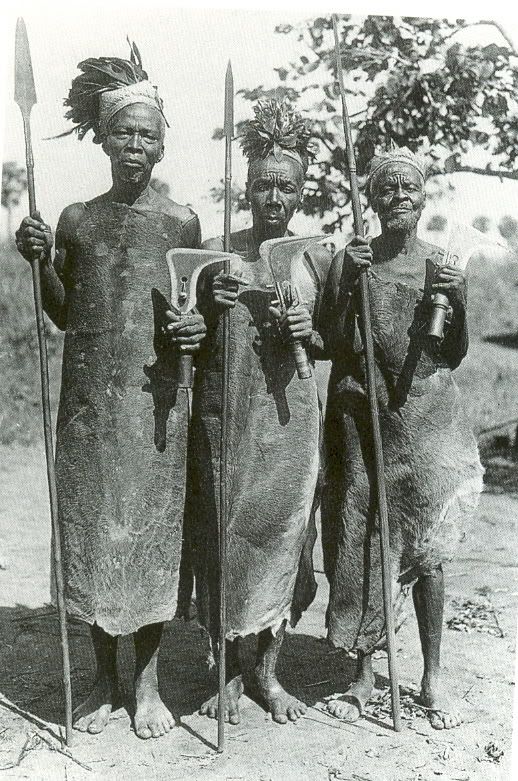 Next is a Ngiri warrior from Congo in full battledress (photograph taken in 1916). The second picture shows his body armour. 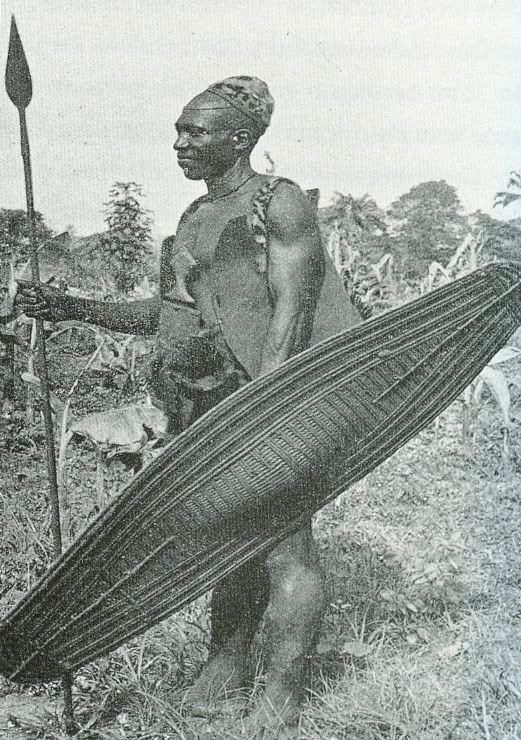 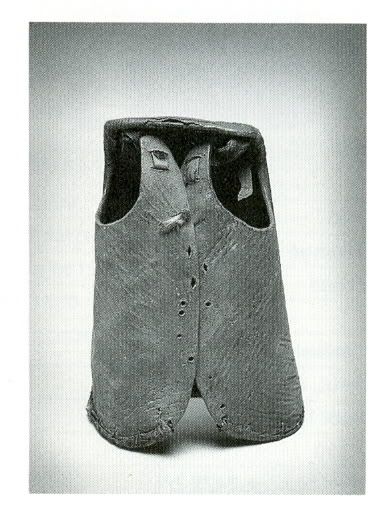 Third is a kind of helmet from the Mbala in Congo : 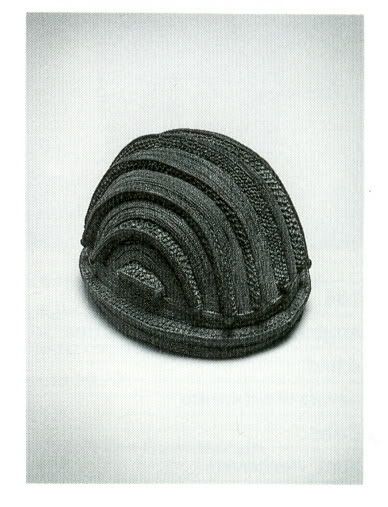 Last, but not least are som Mali horsemen with their horses in full armour. This armour consist of thick cotton clothing. 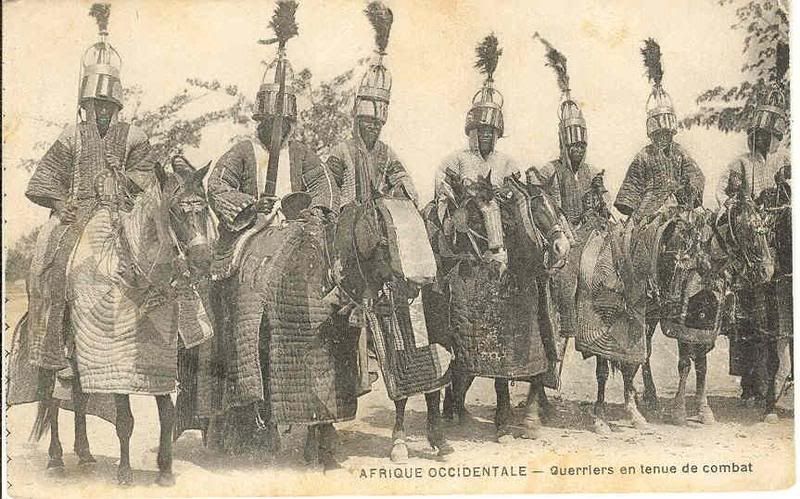 All this would surely protect against spears, arrows and other bladed weapons. |
|
|

|
|
|
#7 | |
|
Member
Join Date: Jul 2006
Location: musorian territory
Posts: 424
|
Quote:
i was after indiginous invention. and styles. otherwise one could show a picture of a cutlas or machete from the 17th centuary yukatan and say it was made by mayan culture becasue the person who wore it or forged it was of mayan decent,,,,.. the item still could nto be considered native,, or more correctly native to the previous culture, what im interested in in amrour purly native to africa, it appers that the central western part of africa had a unique style in making their weapons, and a unique concept in how they should be used and what for, and so i am facinated as to how they made them and how the technique evolved. as normaly where more and more metal working is undertaken in larger amounts, skill increases and technique forms more precisly.. and so the understanding of steel increases and is transfered to the next smith, in areas where many many tools or weapons are produced that are alike you get an increase in the quality as each smith compeats to sell his work and each user wishes his item to be more superior than the next mans.. s you can get a simple golok,, with a poorly treated blade and a crude grip.. and you can get a fine one made of folded steel with a ivory grip and exsotic wood on the sheath.... ... ive noticed that most african knives had large flaws in the blade, and as i dont know what type of smithing techniques they sued i woudl hazard a guess in that they used a stone anvil and proably very simple tools.. still to put so meany fullers into the itmes would take quite some work without good tools.. but realy the hardening if found is mostly very soft, or none atall, all antique african weaponrt ive found is no softer than a normal machete or other spring hardened item, 45 rockwell or less.. and the blade finish also interests me , was there an ability to polish the blades atall as ive never seen any actualy polish on the.. and for that matter did the people possess any rotary grinding device? or did these only come with the arrival of europeans.. this area of thins is quite of interest as it is a large area and these items were still made in mos recent times, and realy in huge amounts...... as when you look at the numbers of soliders sepcific african cheifdoms had under them.. they are quite large. 5000 or 10000 or more.. and most of these no doubt woudl have had some hand weapons aside from spears.. |
|
|
|

|
|
|
#8 | |
|
Member
Join Date: Jul 2006
Location: musorian territory
Posts: 424
|
Quote:
or the celts, many didnt wear much atal when they fought,,,.. but they had tempering and lamination techniques equial to those used in the middle ages.. as to the heat,, india is as hot or hotter than africa,, and ... welly ou can see armour is very common there... and has always been etheopia is not arctic nation as plate and chaim armour had exsisted ther ein abundance for a very lond time , yemen and oman ,, body armour was very common up untill the late 17th centuary.. heat and armour dont have much relation.... metal working skill and armour do. steel availability does.. warefare techniques do.. so this i find facinating.. the quilted armour comes form the middle east and arived very late.. the crude untreated leather vests ive observed before, but this is far more primative than the armour used in the pacific for exsample, which was realt quite advanced........... and rememebr in the pacific they lacked even leather let alone metal this realy makes me wounder if there was any form of metal brestplate used..... or any other for of armour or any metalic helmets.. gauntlets ect ect.. it so odd that people had mastered iron productin so well but never advanced the metal craft further. i do wounder has there been much research into iron use in africa, i wounder how long iron weapons have been made in large numbers there, and how long swords have exsisted there.. and what the previous styles were like.. and if bronze or copper were used before that to produce swords ..... i wounder how long these styles have exsisted and what sort of swords were before, . |
|
|
|

|
|
|
#9 |
|
(deceased)
Join Date: Dec 2004
Location: East Coast USA
Posts: 3,191
|
[QUOTE=ausjulius]come now tell that to the dayaks... :P
or the celts, many didnt wear much atal when they fought,,,.. but they had tempering and lamination techniques equial to those used in the middle ages it so odd that people had mastered iron productin so well but never advanced the metal craft further. ausjulius From what I know the Celts and middle age swords were mostly spring tempered to between 45-50 Rockwell and the laminated blades consisted of a central core which had an outer edge of harder steel welded around the core. I saw no evidence of a differential heat treat or the use of san mai or clay tempering techniques as found in Asian blades. You also must take into consideration that there was a great deal of trade going on of ideas and goods between India,Persia,Central Asia,China and North Africa which may not have reached Central Africa the Congo and South Africa. So the Bantu smiths forged blades in very primitive forges consisting of a hole in the ground a basic bellows and a stone anvil. What they produced worked just fine for their type of warfare and there was no need to fix what was not broken. There was an arms race of in Asia and MidEast and Europe that atributed to the evolution of better arms and manufacturing techniques which in the end produced superior steel bladed weapons which now we see today. As far as the use of armor is concerned the Mid East was hot and dry as was Rhajistan in India so wearing metal armor or chail mail may not have presented as much as a problem as in central Africa were you can have the same heat but with 90 percent plus humidity and the humidity would not only kill you faster via heat stroke but would cause the armor to rust faster. Lew Last edited by LOUIEBLADES; 14th June 2008 at 04:18 PM. |
|
|

|
|
|
#10 |
|
Member
Join Date: Dec 2004
Location: What is still UK
Posts: 5,807
|
Personally I do not get this fascination with hardness. You can hurt or kill somebody with a plastic Biro. This one of my most favourite African pieces. Quite modest but so masterful. Tempered more than enough to damage a soft bodied creature. Just look at the beautiful forging like a sculptor working in a soft wax or clay. To me wonderful and perfect.
|
|
|

|
|
|
#11 |
|
(deceased)
Join Date: Dec 2004
Location: East Coast USA
Posts: 3,191
|
I must Agree with Tim hard edge tempering on blades is not relevant if you are not using it against hardened armor. Below are a few examples of beautifully made central African daggers. The two on the left are quite springy stiff with thicker steel blades as a matter of fact the second from the left has some lamination present and reminds me of some older Celtic small swords that I have seen. You all should know that the choice of weapon that has killed more people in Africa in the last 100 yrs is the machete which is spring tempered.
Lew |
|
|

|
|
|
#12 | |
|
Member
Join Date: Jul 2006
Location: musorian territory
Posts: 424
|
[QUOTE=LOUIEBLADES]
Quote:
on the viking swords for exsamples there is some seaxs and sowrds that surpass even the most complex japanese blades...... unfortunatly there is proably ot a great deal of willingness of the museams in europe to let people mess with so valuable items, shrilanka and southern india are,, not hot and dry, they are humid and whet and armour abounds, as in vietnam and southern china.. for exsample.. hell the spanish wore it in south america for quite some time, id say cultural and technical nothing to do with heat, kiribati it very how and humid, but there exsists very complext body armour.. this has to be as hot as the steel arounr of europe. technology and culture dosnt have much to do with heat. but still there must have been something even alittle of metalic body armour ,, and remember the africans had contact with europeans and arabs for along time ,look how old angola is and remember the portagese were using armour in africa not a regualr basis as were the dutch thers many acocunts of this .. i wounder if there was not some basic metal armour or chest plate developed at some point in this area, it is very surprising,, ' |
|
|
|

|
|
|
#13 |
|
(deceased)
Join Date: Dec 2004
Location: East Coast USA
Posts: 3,191
|
ausjulius
I really can't explain why since you have put holes in my hot and humid theory  . Most of the swords I have from that region of Africa are under 24 inches long the symetrical ones are made more for stabbing rather than hacking. Maybe they preferred spears to swords as their main battle weapon they are easier to produce and do not need to hard be tempered? It could be just a cultural thing or maybe they did not have access to large amonts of good quality Iron ore? All I know is that their weapons were very effective for what they were designed to do. I think if you studied how these tribes fought, battle tactics and such it may shed some light on the subject. From what I can remember Zulus for years fought by having there warriors take turns throwing light weight spears at each other from a distance until Shaka came up with the larger heavier bladed stabbing spears and close quarter combat tactics similar to what the Romans used with their gladius and shields. . Most of the swords I have from that region of Africa are under 24 inches long the symetrical ones are made more for stabbing rather than hacking. Maybe they preferred spears to swords as their main battle weapon they are easier to produce and do not need to hard be tempered? It could be just a cultural thing or maybe they did not have access to large amonts of good quality Iron ore? All I know is that their weapons were very effective for what they were designed to do. I think if you studied how these tribes fought, battle tactics and such it may shed some light on the subject. From what I can remember Zulus for years fought by having there warriors take turns throwing light weight spears at each other from a distance until Shaka came up with the larger heavier bladed stabbing spears and close quarter combat tactics similar to what the Romans used with their gladius and shields.Lew Last edited by LOUIEBLADES; 19th June 2008 at 10:23 PM. |
|
|

|
|
|
#14 | |
|
Member
Join Date: Jul 2006
Location: musorian territory
Posts: 424
|
Quote:
yes  i think heat was not it.. i think heat was not it.. i would say cultural.. from what i understand the african iron mostly has alot of impurities in it so i guess this is where the chipping and bent or soft blades and such comes from.. yes it appears clubs , spears and sheilds were the main desired items in combat in this area. im interested if the ruling classes took part in combat or were they only observing, as generaly a refinment of weapons and the use of armour comes in a society where this is common, (people incharge dont like to get hurt  ) )still im interested about the tools they used , does anyone have any pictures of the equiptment of a 19th centuary blacksmith of this area? (ah also speeking of the celtic and viking weapons and the lamination,i have sp[oken some time back to somebody who was involved in examining these ill look to get a picture of the blade, i belive some were polished and the laminations shows) |
|
|
|

|
|
|
#15 |
|
(deceased)
Join Date: Dec 2004
Location: East Coast USA
Posts: 3,191
|
Look at this
 http://www.newscientist.com/article/...can-forge.html http://books.google.com/books?id=phg...m=11&ct=result Last edited by LOUIEBLADES; 20th June 2008 at 03:31 AM. |
|
|

|
|
|
#16 |
|
Member
Join Date: Dec 2004
Posts: 1,247
|
So far as short blades vs. long blades, I think the problem is the size of the anvil. I know that two-handed swords (either European or Japanese) were hard to make, and hard to temper properly, because they were often too long for the forge. If you've got a small forge, short blades are much easier to make.
Ditto with complex shapes and tempering. Something with complicated curves and cutouts is going to heat unevenly, and it's going to be hard to temper evenly. I would expect perhaps spot hardening (as on a kukri edge) at best. One problem we haven't discussed is the issue of history. Most of the African blades we see are post-colonial in origin, and most (not all!) were not produced for war. Here's an analogy. Imagine that the only European swords you saw were produced around 1900. How would you judge European sword culture? Probably, you'd figure that swords were minor and ceremonial weapons, as all the blades you could find were badly made (compared to, say, a 14th century sword) and poorly used. Because Africa doesn't have a great historical record, it's somewhat hard to judge how good African swords were or could be. All we see are the modern ones. Just a thought, F |
|
|

|
|
|
#17 |
|
Member
Join Date: Dec 2004
Location: What is still UK
Posts: 5,807
|
I would have bought this book but have my eyes on other things. I have snatched this picture though.
http://cgi.ebay.co.uk/ws/eBayISAPI.d...MEWA:IT&ih=025 |
|
|

|
|
|
#18 | |
|
Member
Join Date: Jul 2006
Location: musorian territory
Posts: 424
|
Quote:
look for exsample at the size and complexed awkward shapes these african weapons come in,, they were using a crude anvil to make these, these shapes are much much harder to form that a european or japanese blade shape which is very simple by comparison, apsecialy the japanese blade. a good exsample of good tempering is blades made fomr semi nomadic groups in borneo.. thes epeople use very crud tools but the treatment and finish of their wepaons is very impressive for teh tools they used,, when you look at old weapons of their from 18th and 19th centuary which were collected they are very well hardened and made.. but they had much less resources and no more complex tools that in africa, just good technique, african blades are hard to make, compared to a simple stirght blade. and would take alot of work to produce, the poor heat treatment and hardening is comon just the same in simple tools and knvies as in complexed tools and knives , it is not the shape, although no doubt it would be worse in more complexed wepaons, id say you can find many many african blades from the 19th centuary and quite alot from the 18th centuary and the styles are similar as is the quality. i thin ingeneral most swords were not used for combat,, but they ust have used some as there is accounts of them doing so , a sword made around 1900 for military use is a cheaply made functional item.. ... its use is instantly apparent .. and it is designed for a function, the afircan swords ive seen ive never been able to see any use for any of them, the masi knives yes, they are a multi tool basucaly in the style of their spears. the swords of ethopia yes and many appear to be use and had a specific technique to use them, but the congo area of affica,, the "african" africa, swords just, seemed to be...... mostly decorative,, or....... made more for a shape that for a use, even the small galdius type swords they have no guard and no pommel cap and the handle is just a hunk of green wood pushed into the hand and peen over, mostly the handles are broken or split, if these were being used so often then i would exspect them to use metal in the guard and pommel, and even atlease finish the wood well and maybe use a better wood, it is interesting no doubt the swords held some cultural importance for rank and power, but how important if at all were they in combat, the mosy afirican spears and clubs although routhly made are rather fucntional items that are made for a task that is apparent when you see them the same goes for bows, but when it comes to swords,, "klingonish" comes to mind :P however ,, i realy wounder how old these odd styles are, and was there some stlyes before that that were more simple and more functional?? also , im interested,..... has ther ebeen any study as to when the sword came into africa and what styles came and what part did the arrive first. as it realy is clear the concept of a "sword" is something people learn from one groups to the next. hence the different types in earily history spreading around.. Tim, thanks looks like an interesting book , however the individuial in the picture is mostlikeliy a moslem frim the north of this region near camaroon and nigeria ,e ct ect,, and not form the southern non arab influenced areas,, hence the horse and the armor. still even this is interesting, as i wounder why it never spread further south, realy somebody must have a closer look at all this are africa seems to be rather under researched, and it is interesting to have some information on these things, |
|
|
|

|
|
|
#19 |
|
(deceased)
Join Date: Dec 2004
Location: East Coast USA
Posts: 3,191
|
I think most of the African longer swords from the Congo were more status symbols than actual weapons. Some of their shapes are not really that practical in combat. Spears,clubs and bow and arrow were probably their best weapons and the dagger for real up close encounters. There are a few exceptions though such as in this sword. Heavy blade with a very well made point. Many tribes often used axes in war such as the two pictured below. The point here is that these weapons were developed based on the type of warfare that was common at that time and since the other tribes were not developing any new forging or heat treatment techniques that were producing substantionally superior weapons than there was no need for an arms race to make better weapons as was apparent in the Asia,Europe and the Mideast. Btw the viking sword was a complex wonderful piece of steel but was very expensive to produce and was quite costly to the owner to afford. The viking weapon of choice was the spear and the lowly axe which had a simple Iron head axes were easy and cheap to make. Battle field weapons evolve due to adjustments to the enemies tactics and weapons. In Japan the use of the straight double edged sword was abandoned sometime after 1276 after they realized that it was not very effective against the invading Mongols and created the tachi/katana or curved sword which was more effective. The style of the Japanese sword has changed very little from 1300-1800s because it did the job it was designed to do and it did it well. The same goes for African weapons the smiths just did not need to improve their techniques what they had did the job. Necessity is the mother of invention
 Lew Last edited by LOUIEBLADES; 23rd June 2008 at 06:53 AM. |
|
|

|
|
|
#20 |
|
Member
Join Date: Dec 2004
Location: What is still UK
Posts: 5,807
|
This is a nice weapon. The beak is 26cm long, not a toy and anybody could pick it up and fight with it. So you see some super things yes?. Lew and I have done so well without Danny, Freddy, Luc and others
 sure there is more to follow sure there is more to follow  huh huh
Last edited by Tim Simmons; 23rd June 2008 at 10:29 PM. Reason: spelling |
|
|

|
|
|
#21 | |
|
Member
Join Date: Jul 2008
Posts: 2
|
Greetings, fellow lovers of world culture. I'm new to this forum, however, not new to the topic. I am a blacksmith who specializes in recreations of African weapons and the owner of African Arms.
Let's see...where do I begin?  I'll start with the mail shirt posted earlier on this thread. It's ceremonial.  A common mistake made by many when viewing mail of this type is to assume that it's functional. Mail of this caliber was never meant to see combat. This mail shirt is a talismanic ceremonial expression. A tell tale sign of this are the Arabic inscriptions placed on every single link. It is a tribute and a sacrifice of one's time and effort to show their religious devotion and was worn on ceremonial and festive occasions. Real functional combat mail worn by the Sudanese was much more closely linked. Quote:
 Also, the Romans would have no mail armor if were not for their encounters with the Gauls who they considered to be of another race in the modern sense of the word. Are we to say that mail armor is not Roman? As for your example of the 17th century Yucatan cutlass, ausjulius, this would not apply to Sudanese mail armor. For these warriors wore this armor in the middle ages and birthed kingdoms with it. It is not as if this armor was worn centuries later at a time when their descendents were no longer referred to as Sudanese which would have to be the case in your example of the Mayan descendent from the Yucatan. |
|
|
|

|
|
|
#22 | |||
|
Member
Join Date: Jul 2008
Posts: 2
|
Quote:
Quote:
Quote:
Regarding the poor quality of the Congo area weapons you are used to seeing... This is because the African weapons from the Congo regions you've seen are ceremonial and never meant for combat. All you would have to do is ask an African from that region and they will tell you so. I touch on this topic a lot on my website. And in the case of metal guards and pommels, that is a functional aspect turned cultural used when the sword hilt needed to be peened in the absence of powerful glues and/or high quality wood. Have you ever seen Philippine or Indonesian weapons? They often have wooden hilts. Some peened, sometimes not. By the way, there is no "african" Africa. There's only Africa. Lastly, I would like to point out to all that laminated construction and pattern welding are not immediate signs of quality. The origin behind the ingenuous invention of laminated construction and pattern welding was the pursuit of survival when man was faced with poorer quality iron and could not make a strong enough homogenous blade from that iron. The magnificent Japanese sword blade (which I have been in love with for years) was truly born out of a survival situation and is a well executed response to the lack of quality iron. Wootz is known for it's great strength and amazing cutting ability. And it's homogeneous. One piece of steel. With amazing tempering creating hard and soft spots everywhere through out the blade. There's so much more that can be covered when involving Africa, but I must close as I am running short of time right now. I truly hope that I haven't offended anyone. My intentions were to inform and shed new light on this discussion. I really appreciate this forum as an excellent place to come and discuss world history with many different people interested in the same things. Thank you all and have a nice day. 
|
|||
|
|

|
 |
|
|